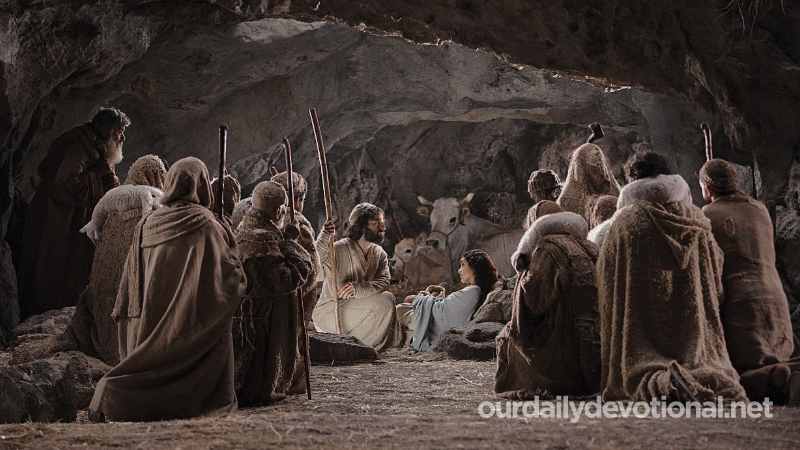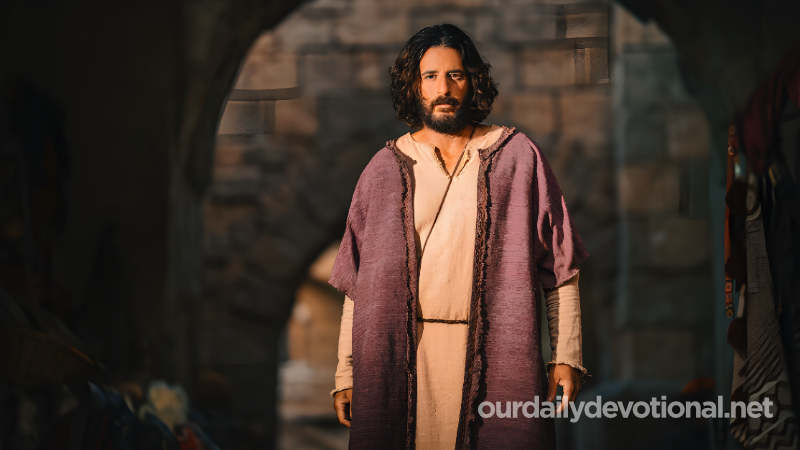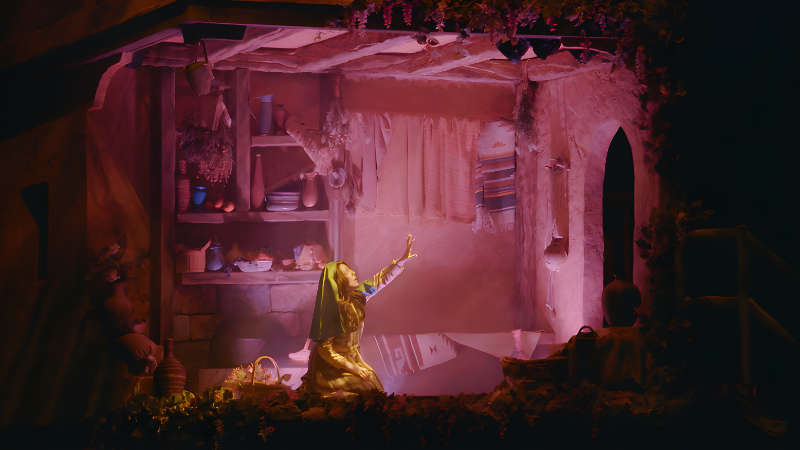From lat. "in", and "caro", "flesh": the fact of assuming a body of flesh; the act by which the Son of God voluntarily put on a human horn and human nature.
The incarnation of Jesus Christ is the culminating point of the revelations and manifestations from God in the sensible world. Because of his very essence of love, God did not want to remain isolated. He wanted to manifest and, finally, incarnate.
Thus he initially created the angels and the heavenly creatures, that is, the servant spirits (Heb. 1:14); with them, to the sensible universe that exalts its glory in the eyes of the heavenly creatures (Ps. 19:1). Matter is not the enemy of God, but an instrument that God uses to manifest his power and glory.
This testimony of divine power is of such clarity, despite the disorder that Satan has introduced into the physical world, that those who refuse to consider it are inexcusable (Rom. 1:20; cp. Acts 14:17).
Even more than the starry heavens and the seasons, even more than the natural creation, man, created "in the image of God" (Gen. 1:26, 27) had to manifest in the flesh the glory of his Creator: the love, righteousness, intelligence, order, all essential characteristics of divinity.
We know how this divine plan was violated in Eden, where man was seduced by the enemy of the Lord, and came under the power of Satan and became a son of the Devil (1 John 3:10). Then, God began to manifest himself in man-witnesses, such as p. e.g., Enoch, who walked with God (Jude 14), Noah the righteous (Gen. 7:1), Abraham, the friend of God. Through them, God revealed his will. Then came the collective testimony: Israel, which would be God's witness to the nations.
God manifested himself in another way, in the Bible. One can go so far as to say, in the words of Adolphe Monod, that Scripture (OT and NT) is like "a spiritual incarnation." It is through the message of the inspired writers (prophets and pastors), chosen instruments of his revelation and vehicles of his thought, that God has spoken to men.
However, despite all the means used, a great separation between the Creator and the creature persisted. God had acted, spoken, but had not yet come personally to work salvation, and to restore the personal contact broken in Eden. Isaiah, the great prophet, expresses the plea of all suffering humanity when he cries: "Oh that you would rend the heavens and come down...!" (Isaiah 63:19). He also gives the wonderful promise: “Be strong, do not fear; behold your God......; God himself will come, and he will save you »(Is. 35: 4).
Certainly, God had appeared in theophanies (see), the appearances of the Lord to the patriarchs and the people of Israel (Gen. 18:1; 32:28-30; Ex. 3:2-7; 19:20; 24 :10; 33:11, etc.). But these were only of an exceptional and temporary nature. The Plan of salvation led inevitably to the incarnation, to the coming of God in flesh, in Jesus Christ.
According to the OT, the Messiah was to be Jehovah himself, the only Son of God capable of saving (Ps. 2; 45:7-8; 110; Is.7:14; 9:5; 35:4; 40:9 -11; Jer. 23:5-6; Mi. 5:1; Zech. 12:1, 10; 14:3-5). On the other hand, this Messiah would be the offspring of the woman, of the offspring of Abraham, of Judah, and of David (Gen. 3:15; 22:18; 49:10; 2 Sam. 7:12-16); he would become a man of sorrows, and he should offer his life on the cross as a sacrifice for sin (Is. 53; Ps. 22:1-22; 40:7-9). How can these two things be possible?
The NT gives a luminous explanation: "And the Word became flesh and dwelt among us... full of grace and truth" (John 1:14). "God, having spoken many times and in many ways in former times to the fathers by the prophets, has in these last days spoken to us by the Son" (Heb. 1:1, 2).
It is only this manifestation that can quench man's thirst: thirst to return to the relationship with his Creator, to receive the certainty of his total love and of his eternal salvation. "It is necessary to live without religion, without God in the world and without hope, or receive the mystery of the incarnation" (Vinet).
When the time was fulfilled, God sent Jesus Christ into the world. The Christ, second Person of the Trinity, is God. "In Him dwells bodily all the fullness of the Godhead... all things were created through Him and for Him" (Col. 1:16; 2:9; cp. 1 Jn. 1:1-18).
He is the “lamb without blemish and without blemish, destined before the foundation of the world, but revealed in the last times” (1 Pet. 1:20). «He is the image of the invisible God, the firstborn of all creation. For in Him all things were created, those in heaven and those on earth...
And He is before all things, and in Him all things hold together” (Col. 1:15-17). He is the Son, whom God “appointed heir of all things, and through whom he also made the universe; who, being the brightness of his glory, and the express image of his substance (upholds) all things by the word of his power” (Heb. 1:1-3). Jesus said of himself: "Before Abraham was, I am" (John 8:58).
At the same time the Savior is truly a man like us in everything except sin (Heb. 2:17; 4:15) if He is the eternal Christ, He is also Jesus of Nazareth, the One who is named in the Gospels more than 80 times as "the Son of man" Jesus Christ.
Of Him John the Baptist could say: "After me comes a man who is before me because he was before me... And I saw him, and I have testified that this is the Son of God" (Jn. 1:30-34). Paul speaks of Him who, born of Israel according to the flesh, is God over all, blessed forever (Rom. 9:5 cp Rom. 1:3-4)
How the incarnation took place and how the two natures, the divine and the human, were united in the single person of Jesus Christ, is a mystery that surpasses us. Without explaining this mystery to us, Scripture simply affirms to us the fact of the miraculous birth.
Born of the Holy Spirit and the virgin Mary (Mt. 1:20-25; Lk. 1:31-35), the Lord is perfectly man and perfectly God: man, to be in solidarity with our race and to represent us before the Father , like our goel (see); God, to take away our sins and to create a new humanity in our favor.
Those who claim not to be able to accept such an inexplicable doctrine can be asked how they explain the union of body and spirit in man. Where is your common link? Where exactly does one end and the other begin? This is the mystery of life, which we confirm without being able to explain, in a similar way to the union of the two natures in Christ.
In the gospels, Christ calmly affirms the ultimate consequences of the fact of the incarnation: "He who has seen Me has seen the Father" (John 14:9). “I and the Father are one” (John 10:30). The Jews who understood him perfectly took stones to stone him, because you, being a man, made yourself God” (John 10:33).
Attacks against the doctrine of the incarnation have been numerous since the first centuries.
The Gnostics denied its reality and reduced it to a mere appearance (docetism).
The Arians rejected the divinity of Christ, seeing in Him nothing more than a creature.
In our time the liberal or rationalist conception follows this line, claiming that Jesus was simply a man, son of Joseph. John solemnly confronted such denial (1 Jn. 4:2-3; 2 Jn. 7-11), denouncing that it comes from the spirit of Antichrist.
The importance of the incarnation is certainly fundamental. By itself, it accounts for the essential divinity of Christ, which entails his eternity, his perfect holiness, his miracles, his power, his absolute demands.
At the same time, he explains facts that, in view of all the above, would seem contradictory: his humiliation, his human limitations, his sufferings, his agony. Because it is evident that if He "participated in flesh and blood" He did so in order to be able to die for us (Heb. 2:14).
The purpose of the incarnation, thus, was not only to come to speak to us and reveal God to us, but above all to give way to the cross. He who was "in the form of God" emptied Himself; He appeared as a simple man, and became obedient to the death of the cross (Phil. 2:6-11).
God, with his absolute moral perfection, could do nothing but judge us; and He descended in the person of Christ to offer Himself for our salvation. "God was in Christ reconciling the world to Himself...He made Him who knew no sin to be sin for us, so that we might become the righteousness of God in Him" (2 Cor. 5:19, 21).
By an incomprehensible grace in taking his place again at the right hand of the Father, the resurrected Christ retains the mark of his incarnation. He is the glorified Son of man who showed himself to John (Rev. 1:12-18); and as such he will appear in the clouds of heaven (Dn. 7: 13-14; Mt. 16:27; 24:30; Rev. 1: 7); and it is with the marks of his sufferings and death that he will be eternally worshiped in heaven (Rev. 5:6-14).
Yes, great is the mystery of godliness: "He who was manifest in the flesh...believed in the world, ascended into glory" (1 Tim. 3:16).
Meaning of INCARNATION
From lat. "in", and "caro", "flesh": the fact of assuming a body of flesh; the act by which the Son of God voluntarily put on a human horn and human nature.







